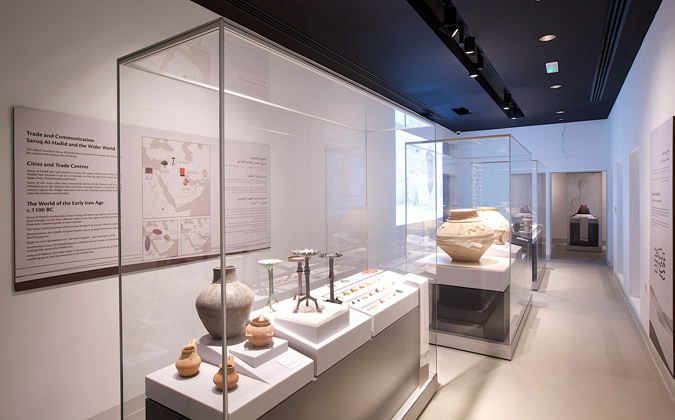What are the old civilizations that lived on the UAE’s land, and are we connected to them like other countries are connected to their previous civilizations?

In the past, many thousand years ago, people have documented parts of their lives such as their beliefs and significant events on walls and even on stones. Without access to those archives, researchers exploring the lives of ancient civilizations will face many difficulties and obstacles. Those archives are what lead us to know more about the history of the lands we live on. In this article, we’ll explore the earlier civilizations on the land of the UAE’s, which were discovered through the access to such old archives.
There have been many archaeological findings that prove that the UAE as a land had ancient civilizations settled on it. The most recent discovery was the Saruq Al Hadid Archaeological Site, which dates back to the Iron Age. However, how much are these civilizations linked to the people living in UAE? Is it considered to be part of their history and identity and will it be ever considered one? How much are the education system and parents teaching their children about these civilizations, and do they consider them as their ancestors?

These settlements did not share with the UAE nationals’ anything except the land they lived on. They had different religion, beliefs, language, culture, and tradition. However, Pharaohs did not share the above aspects with Egyptians either, but many of Egyptians have a strong connection with them. Perhaps it’s because we are not aware of these civilizations as they are only recently discovered. Moreover, what is the role of individuals, community, and the country toward paying attention to include such valuable civilizations as part of who we are as Emiratis?
The land of the UAE has a very ancient history, dating back to the first human settlements, which appeared in the late Stone Age. One of the oldest settlement found in the UAE was six thousand years before Christ (BC) to the era of Delma and Marawah, and is known as the civilization of the “slave” Valley Rivers (Al Aboudi, 2009b: 121). Moreover, there is evidence of earlier settlements in the region during the emergence of the civilizations of Mesopotamia and Ancient Egypt. In the Bronze Age (3200-1300 BC), the Gulf Arab Emirates had a role in trading copper and pearls to the empire of Mesopotamia, and imported ivory, pottery and other goods from Afghanistan, Iran and the Landis Valley. Maliha archaeological site in Sharjah showed evidence of trade links with Greece in the third century before Christ (Daniel, 2003). Furthermore, the excavations around the UAE uncovered very rich Neolithic finds, which can be found at Sharjah Archaeology Museum or at Mleiha Archaeological Centre. Moreover, trading posts existed by 4,000 BC on the Emirati coast, as it was trading maritime products with Mesopotamia. The Portuguese occupation of the coast of Oman, which become the Emirates later, found that the dhows of the empire of Ormus sailed as far as India, China, and Tanzania.

Another important era in the United Arab Emirates history is the rise of Islam to the Arabian Gulf region, as it was a turning point for Arab tribes and people. Prophet Mohammed, peace be upon him, sent messengers bringing the message of Islam to heads of the Arab Tribes, and they responded without any hesitation. Thus, the Arabian Gulf countries entered a new era, and lots of beliefs and perspectives changed because of the new religion. Islam, as an ideology, fought against the beliefs and mindsets of what Islam called the “ignorance” age, which Arabs used to follow before the rise of Islam as a concept and practice. Islam was a social, cultural, intellectual, political, military, and economic revolution. However, it built upon previous prophets, religions, practices, and ideas, and it took them as its foundation. This has a very direct connection to the identity of the people and their knowledge of who their ancestors were.
Emiratis have a very strong sense of pride regarding their culture, tradition, leaders, religion, and nation. Anderson (2006) describes a nation as a socially constructed community imagined by people who perceive themselves as a part of a group. They might never meet each other but they might have similar interest and beliefs. This is the case in the UAE; the government spreads its national ideology through mass media, the education system, administration regulation, cultural institutions such as museums, and so forth.
In conclusion, from only snapshots of the UAE’s history shown above it demonstrates its rich civilizations. It still needs to be discovered. Those lives and their work laid the foundations on which we build our lives. Because of us, future generations will be proud and knowledgeable of their rich civilization. They will look at the change of civilizations over time which created a cultural diffusion with the spread of its ideas, customs, and technologies from one people to another. We are a diverse society, which consists from the migration from around the area and the old civilizations.
References
AL ABOUDI, N. H. 2009b. Pages from UAE’s archaeology and histroy, Dubai, The Ministry of Culture, Youth and Community Development.
ANDERSON, B. 2006. Imagined communities: reflections on the origin and spread of nationalism, London, Verso.
AS’EED, M. & SHORAB, Y. 2011. Emirates Society Originality and Contemporary, Kuwait, Al Falah Books
BIN SARRAI, H. 2005. Oman from third century BC to seventh century AD, Hawaly, Al Falah Bookshop.
BOUMANSOUR, F. 2011. The Role of Museums in Emirati Culture. Museum International, 63, 11-25.
BRISTOL‐RHYS, J. 2009. Emirati Historical Narratives. History and Anthropology, 20, 107-121.
DANIEL, T., AL NABOODAH, H. & HELLYER, P. 2003.Archaeology of the United Arab Emirates, Sharjah, Trident Press L



